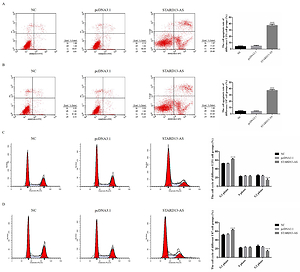Current issue
Archive
Manuscripts accepted
About the Journal
Editorial office
Editorial board
Section Editors
Abstracting and indexing
Subscription
Contact
Ethical standards and procedures
Most read articles
Instructions for authors
Article Processing Charge (APC)
Regulations of paying article processing charge (APC)
NEUROLOGY / RESEARCH PAPER
Long non-coding RNA STARD13-AS suppresses glioma cell biological activities by vitro study
1
Department of Neurosurgery, Yuhang District First People’s Hospital, Hangzhou, China
Submission date: 2021-04-13
Final revision date: 2021-05-06
Acceptance date: 2021-05-22
Online publication date: 2021-06-04
KEYWORDS
TOPICS
ABSTRACT
Introduction:
It has been unclear whether STARD13-AS has effects in glioma. The aim of our research was to investigate the effects of STARD13-AS in glioma development and the mechanisms underlying these effects.
Material and methods:
Adjacent normal and tumor tissues were collected for long non-coding RNA (lncRNA) microarray screening. STARD13-AS expression was measured by in situ hybridization (ISH) and reverse-transcription quantitative PCR (RT-qPCR) assays, and correlations between STARD13-AS and clinicopathological parameters and prognosis were analyzed. STARD13-AS transfection of glioma cell lines (U251 and U87) was used to evaluate biological activities of cells. Western blotting (WB) and RT-qPCR assays were used to investigate the underlying mechanisms.
Results:
According to lncRNA microarray screening, ISH, and RT-qPCR, lncRNA STARD13-AS was significantly downregulated in tumor tissues. Low STARD13-AS expression was strongly correlated with poor prognosis and malignant clinicopathology. After STARD13-AS transfection, biological activities of glioma cells were significantly decreased (p < 0.001 for both cell types). WB and RT-qPCR assays showed that protein and mRNA expression levels of cyclin D, cyclin E, N-cadherin, E-cadherin, and vimentin were significantly related to STARD13-AS overexpression (p < 0.001 in all cases).
Conclusions:
STARD13-AS overexpression suppresses the biological activities of glioma cells, indicating that STARD13-AS is a potential target for glioma treatment.
It has been unclear whether STARD13-AS has effects in glioma. The aim of our research was to investigate the effects of STARD13-AS in glioma development and the mechanisms underlying these effects.
Material and methods:
Adjacent normal and tumor tissues were collected for long non-coding RNA (lncRNA) microarray screening. STARD13-AS expression was measured by in situ hybridization (ISH) and reverse-transcription quantitative PCR (RT-qPCR) assays, and correlations between STARD13-AS and clinicopathological parameters and prognosis were analyzed. STARD13-AS transfection of glioma cell lines (U251 and U87) was used to evaluate biological activities of cells. Western blotting (WB) and RT-qPCR assays were used to investigate the underlying mechanisms.
Results:
According to lncRNA microarray screening, ISH, and RT-qPCR, lncRNA STARD13-AS was significantly downregulated in tumor tissues. Low STARD13-AS expression was strongly correlated with poor prognosis and malignant clinicopathology. After STARD13-AS transfection, biological activities of glioma cells were significantly decreased (p < 0.001 for both cell types). WB and RT-qPCR assays showed that protein and mRNA expression levels of cyclin D, cyclin E, N-cadherin, E-cadherin, and vimentin were significantly related to STARD13-AS overexpression (p < 0.001 in all cases).
Conclusions:
STARD13-AS overexpression suppresses the biological activities of glioma cells, indicating that STARD13-AS is a potential target for glioma treatment.
Share
RELATED ARTICLE
We process personal data collected when visiting the website. The function of obtaining information about users and their behavior is carried out by voluntarily entered information in forms and saving cookies in end devices. Data, including cookies, are used to provide services, improve the user experience and to analyze the traffic in accordance with the Privacy policy. Data are also collected and processed by Google Analytics tool (more).
You can change cookies settings in your browser. Restricted use of cookies in the browser configuration may affect some functionalities of the website.
You can change cookies settings in your browser. Restricted use of cookies in the browser configuration may affect some functionalities of the website.



